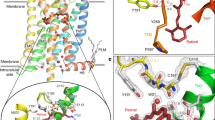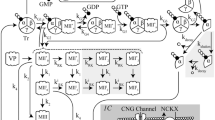Abstract
ABSORPTION of a photon by the visual pigment of a photo-receptor results in a cascade of changes in the pigment molecule. At some time during the later stages of this cascade, a visual response appears, in the form of a change of the ionic conductance of the cell. In order to understand the mechanism of the process coupling the pigment changes to the modulation of the conductance, one should know from which state(s) or transition(s) of the pigment cascade the coupling process originates. In the vertebrate, it is commonly assumed1,2 that the fourth transition in the cascade, that from the state called metarhodopsin I to the state metarhodopsin II, is the predominant source of the coupling, mainly because this is the first transition involving a major molecular conformational change and the last temporally before the appearance of the visual response. Here we show that in the barnacle photoreceptor, transitions to and from the state called metarhodopsin (although its relation to vertebrate metarhodopsin is unclear) cannot be primarily involved in originating the coupling process, which must arise from earlier stages, not later than the second transition of the cascade.
This is a preview of subscription content, access via your institution
Access options
Subscribe to this journal
Receive 51 print issues and online access
$199.00 per year
only $3.90 per issue
Buy this article
- Purchase on Springer Link
- Instant access to full article PDF
Prices may be subject to local taxes which are calculated during checkout
Similar content being viewed by others
References
Ebrey, T. G. & Honig, B. Q. Rev. Biophys. 8, 129–184 (1975).
Ostroy, S. E. Biochim. biophys. Acta 463, 91–125 (1977).
Minke, B., Hochstein, S. & Hillman, P. Biophys. J. 14, 490–512 (1974).
Hillman, P., Hochstein, S. & Minke, B. J. gen. Physiol. 68, 227–245 (1976).
Stratten, W. P. & Ogden, T. E. J. gen. Physiol. 57, 435–447 (1971).
Hillman, P., Hochstein, S. & Minke, B. Science 175, 1486–1488 (1972).
Minke, B., Hochstein, S. & Hillman, P. J. gen. Physiol. 62, 87–104 (1973).
Minke, B. & Kirschfeld, K. J. gen. Physiol. 71, 37–45 (1978).
Minke, B., Hochstein, S. & Hillman, P. Biol. Bull. 147, 491 (1974).
Atzmon, Z., Hillman, P. & Hochstein, S. Isr. J. med. Sci. 14 (in the press).
Hochstein, S., Minke, B. & Hillman, P. J. gen. Physiol. 62, 105–128 (1973).
Hamdorf, K., Paulsen, R. & Schwemer, J. in Biochemistry and Physiology of Visual Pigments, 155–166 (ed. Langer, H.) (Springer, Berlin, 1973).
Razmjoo, S. & Hamdorf, K. J. comp. Physiol. 105, 279–286 (1976).
Strong, J. & Lisman, J. E. Science (in the press).
Author information
Authors and Affiliations
Rights and permissions
About this article
Cite this article
ATZMON, Z., HILLMAN, P. & HOCHSTEIN, S. Visual response in barnacle photoreceptors is not initiated by transitions to and from metarhodopsin. Nature 274, 74–76 (1978). https://doi.org/10.1038/274074a0
Received:
Accepted:
Published:
Issue Date:
DOI: https://doi.org/10.1038/274074a0
Comments
By submitting a comment you agree to abide by our Terms and Community Guidelines. If you find something abusive or that does not comply with our terms or guidelines please flag it as inappropriate.



